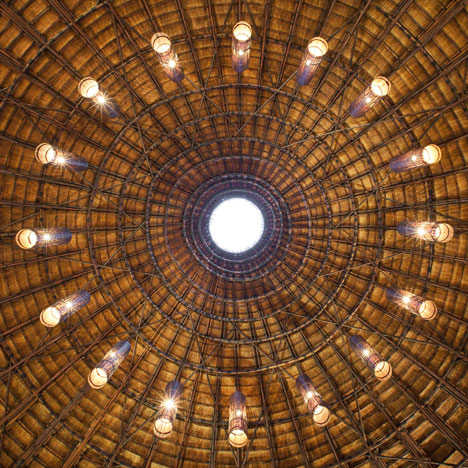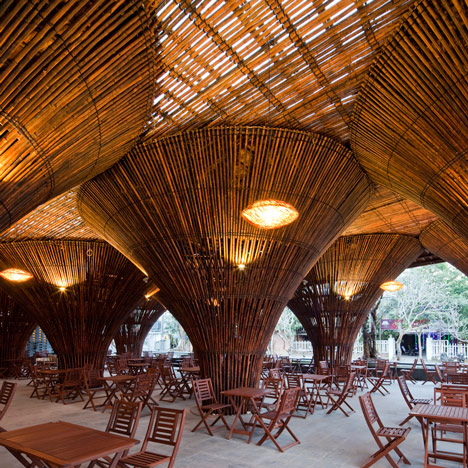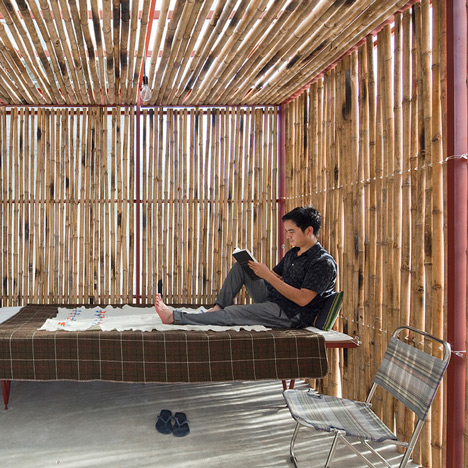Bamboo "will replace other materials" in architecture says Vo Trong Nghia
Bamboo architects: bamboo is the "green steel of the 21st century," according to Vietnamese architect Vo Trong Nghia, one of the leading exponents of bamboo architecture (+ interview + slideshow).
Dezeen spoke to Nghia as part of a series of articles about bamboo architecture we're running this week, following a surge in the number of projects employing the material.
Earlier this week Vo Trong Nghia Architects unveiled designs for the Vietnamese pavilion at Milan Expo 2015, which will be constructed from bamboo, while China-based architects Penda proposed a high-rise hotel built from the material.

"I think bamboo and laminated bamboo will replace other materials and become the 'green steel' of the 21st century," said Nghia. "I hope many architects realise the potential of the material and build with bamboo more and more."
Bamboo, which is an extremely fast-growing species of giant grass, grows abundantly, quickly and cheaply in Vietnam, where canes cost as little as a dollar each.
Nghia learned about its properties first hand when he was a child. "Traditionally, bamboo is used in Vietnam to create baskets, tableware and furniture," he said. "When I was young, I helped my family to make bamboo tableware."
Nghia has completed several projects using bamboo, mostly in his native Vietnam. They range from bars, cafes and restaurants where bamboo is used structurally to form arches and domes, to a proposal to solve Vietnam's housing crisis with cheap, steel-framed homes clad in bamboo.

Nghia's Wind and Water Bar features a 10m-high, onion-shaped dome constructed of bamboo canes and clad in thatch. The frame of the dome is made of 48 prefabricated bamboo ribs.
The practice's Kontum Indochine Cafe features trumpet-shaped, prefabricated columns made of bamboo canes joined together in low-tech fashion with rattan and bamboo nails. Steel fixings were avoided since these can generate too much load in one place, causing the bamboo to buckle. The bamboo was first soaked in mud and smoke-treated – the traditional methods for preserving the wood and eliminating pests.
The Vietnamese pavilion at World Expo will consist of 25 similar columns, each topped with trees.
Nghia's low-cost housing proposal uses bamboo as a cladding material, rather than as a structural solution. Rows of canes are used as louvres between the wall panels, which are made of translucent polycarbonate. Bamboo was chosen as it is cheap, lightweight and easy to replace.
Here's the transcript of the interview:
Marcus Fairs: Why do you use bamboo so often in your architecture?
Vo Trong Nghia: Bamboo is very low cost material in Vietnam. One bamboo stalk costs just 1USD, although its price has started to rise. Bamboo building is suitable to create open spaces or semi-outdoor spaces. Bamboo building is suitable in climates such as Vietnam, where no winter exists.

Marcus Fairs: What properties does bamboo have that make it suitable for architecture?
Vo Trong Nghia: Bamboo is bendable. This is an important character. Using bent bamboos, the structure obtains unique shape and beauty. With proper treatment – soaking in mud and smoking it – bamboo becomes as durable as timber. Thanks to its rapid-growing ability, I think bamboo and laminated bamboo – or engineered bamboo – will replace other materials and become the ‘green steel’ of the 21st century.
Marcus Fairs: What is the tradition of using bamboo in Vietnam?
Vo Trong Nghia: Traditionally, bamboo is used in Vietnam to create baskets, tableware and furniture. When I was young, I helped my family to make bamboo tableware. I learned the property of bamboo from this experience.
Marcus Fairs: Why are architects using bamboo so much these days?
Vo Trong Nghia: Some architects realise the unique properties and advantages of bamboo, while some just use it in a fashionable manner. In any case, I hope many architects realise the potential of the material and build with bamboo more and more.

Marcus Fairs: What projects have you made from bamboo and why?
Vo Trong Nghia: Bamboo is suitable to create open spaces surrounded by nature, for instance cafes, bars, restaurants, resorts and conference halls. Our Bamboo Wing and Dailai Conference Hall near Hanoi airport are typical examples. In addition, bamboo building is also appropriate for pavilions, such as Expo pavilions. We had experience in Shanghai 2010, and soon in Milan 2015.
Marcus Fairs: What is it like working with bamboo compared to other materials?
Vo Trong Nghia: Bamboo has own characters, which result in unique structures and spaces. It is not easy to create beautiful spaces by using bamboo, because it is uneven material. We try to control the accuracy of the construction by applying unit-frame prefabrication.
The other issue of bamboo construction, compared to steel or concrete structure, is difficulty to choose an appropriate contractor. There is almost no contractor with experience of bamboo construction. So, in order to realise the space as envisioned, it is essential for us to educate workers and build the construction together.